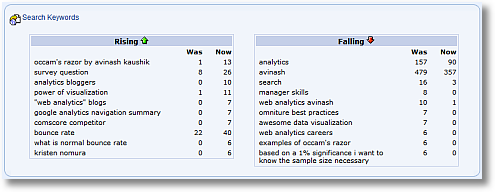Confused about Web Analytics?
How about Web Metrics?
Have you been successfully scared?
Rhetorical questions. Don’t answer. 🙂
Let’s do this one step at a time, first let’s demystify web metrics. We’ll do web analytics another time.
The hardest thing you’ll do in your life as a Web Gal / Guy /
Marketer / Analyst / Researcher / Jack is identify what constitutes
success for you when it comes to measuring Outcomes for your website.
Step two will be to identify the Critical Few metrics to measure those successful company, and hopefully customer, outcomes.
So what makes a great Web Metric? And what are the factors you need
to keep in mind to ensure that your valiant efforts to measure business
success in this first life will be successful? 🙂
This post is inspired from my segment of the WAA’s well received webinar on the newly defined Web Metrics Standards last month.
The intelligent Ms. Angie Brown and the fabulous Mr. Jason Burby
spoke about the tough work that went into creating the new standards. I
spoke about Web Metrics Demystified .
In this post you’ll learn how to find diamonds in the rough, how to
know that a metric you have identified for your Management Dashboard is
actually a good one, and you’ll learn the process you can, and should
use, to keep your web analytics metrics relevant.
Enjoy…..
Four Attributes of Great Metrics:
Metrics are a dime a dozen. Especially on the web. There are books and blogs full of ‘em.
How do you know which one is your must have darling?
In my humble experience here are four attributes that all great, nay magnificent, metrics possess…
1. Uncomplex
Great metrics almost always are uncomplex.
Because we did not make much headway with recommended metrics
foisted on us, our response has been to create complex metrics. Six
things each with its own unique multiplier / variable predicting the
position of the sun when visitors click on your site.
Here is the thing to think about: Decisions in companies are not
made by one person. If you want action then the democracy needs to
understand performance, the democracy need to make decisions.
Not you. Certainly not your consultant. Or best friend.
If you are the only person who understands the metric, the Key
Performance Indicator, then you have just guaranteed that your company,
big or small, will not take action. Because you know the metric, but
not the business.
Don’t sexify, uncomplexify. Solve for the masses making decisions. It is not as easy as you think, try.
2. Relevant
Is the metric you have chosen relevant to your business?
Since we have so many metrics we pick our favorites and then stick
with them. The problem is that each business is unique, even businesses
that seem like they might be in the same business.
In Web Analytics: An hour A Day
I use the example of Best Buy and Circuit City. You might think that
they should / would / could measure their website with similar Web
Metrics. Nothing could be farther from the truth.
 The
The
only thing they have in common is the fact that they sell large screen
TV’s on their website. Everything else is different. Their business
models, their priorities, how each tends to use the web in its
multi-channel portfolio.
The metrics you would use for each company to measure success would be different.
It is ok to seek inspiration from your friends and competitors. In
the end truly stress test that the metrics you identify are relevant
when it comes to measuring the success objectives that are unique to
you and your website.
Remember what works for Jason might not work for Shane. And those two are close! 🙂
3. Timely
A few years back I was interviewing at one of the biggest companies
on the web. They had just closed their quarter, it had been
tremendously profitable. I asked them what the reasons were for that
great success. The rest of this is absolutely positively 100% true.
Them: “We have just kicked off the query against our data warehouse, it typically returns the results in three months.”
Me: Stunned silence.
Granted they were a big business. But still.
I learned a very important lesson on that day. Be on time or die.
That big company’s stock price is a fraction of its price at that
time. While not all of it is related to their ability to measure, you
can imagine how hard it is to be successful in your business (on the
web for Pete’s sake!) if it takes you three months to know what worked
three months ago.
Great metrics can be provided in a timely fashion so that your business decision makers can….. make timely decisions.
I am not a big fan of real-time (see this post: Is Real-Time Really Relevant?
). But between real time and three months there is a sweet spot. Find
out what your sweet spot is and then ensure your data can be collected,
analyzed, and metrics provided with insights in that sweet spot.
Even the greatest metric in the world is useless if takes nine days
to get (with insights!) when your world changes every three days (key
word bids, affiliate bonuses, email promotions, web page updates,
whatever).
Be timely.
Sacrifice complexity and perfection for timeliness.
4. “Instantly Useful”
I absolutely love this one. Smooch, smooch, kiss, kiss.
I credit my early experience with ClickTracks for that love. Dr. Stephen Turner and John Marshall had eliminated all the non value added stuff from the application so that no matter where I went, what report I opened, it was instantly useful.
It was a combination of the fact that there were fewer metrics but
also the fact that they were presented in a way that made it easy to
understand performance and get the first blush of insights.
Instantly useful is when you understand quickly what the metric is,
and you can find the first blush of insights as soon as you look at it.
Here is a great example, the What’s Changed report in ClickTracks:
Anyone can tell you what your keywords were this month, or last
month. The ClickTracks reports shows you “what you should care about”,
keywords that rose in their importance this month and which ones
reduced in importance.
All the complexity is “hidden”, there is no crap, just stuff you should care about. In front of you.
Now does that not simply kick butt? [Click on the image above for a higher resolution version.]
It will take some nice analysis and time to understand all the
nuances and unlock the mysteries and deep stuff (just like say for
example with your wife / girl friend, less so with your husband / boy
friend!).
But the first blush is there. As soon as you look at it.
[I think Google Analytics V2
also does this well through use of layout and color and summaries or
things like Compare to Site Average, Compare to Past etc etc. But I
admit I am greedy. Every time I look at a report, current or new, I ask
for more instant usefulness! Phil and the team humors me by making
stuff even better.]
In a data democracy metrics have to meet the bar of being instantly
useful. And not just that, think of your boss, her boss, his boss. How
little they know. If send them a metric and it is not instantly useful
then it will be instantly ignored.
You want instantly useful, no explanations required, because that
will give you the opening you need to show your “deep stuff”, explain
the nuance, highlight your analysis!
Smooch, smooch? 🙂
Example of a “Great Web Metric”:
Let me give you a very simple example that I think will crystallize the methodology above.
I think Bounce Rate is a “great metric”. Here is how it passes the required four attributes test:
Uncomplex? Single Page View Visits. Easy to understand, explain and propagate. Enough said. 🙂
 Relevant?
Relevant?
It identifies where you are wasting marketing/sales dollars and which
pages stink when it comes to delivering on the “scent”. Those two
things apply to most web businesses. Bam!
Timely? Bounce rate is now standard in pretty much every web analytics tool, and available in every report. Every day. Nice!
Instantly Useful? You can just look at it and know
what needs attention, what needs to stop. You see 25 – 30% for your
site and instantly you know things are fine. You look at a page with
50% bounce rate and you know it needs attention. You see a campaign /
keyword with 70% bounce rate and you know there is a fire.
Set aside half hour today or tomorrow or at the end of the week and
apply the four attributes test to your own important web metrics. What
do you see?
Three Important Final Lessons:
Here are three lessons that are directly from the front lines (sourced from painful battle scars!)…..
1. Perfection is…. the enemy of good enough.
Data quality on the web is not perfect, things change too fast,
everyone wants a piece of data yesterday, your competitors are strong.
Don’t spend time getting things perfect when it comes to your metrics.
If you have 90% confidence in the data (how it is collected,
processed, and presented) then make a decision. Don’t wait for
perfection.
Too many times we spend too much time being distracted by missing
tags and the hoopla around deleted cookies and more. Follow best
practices, then move on. Go for precision and not accuracy.
As Mr. Stuart Gold says: An educated mistake is better than no action at all.
2. Critical few baby, critical few!
I owe Steve Bennett the CEO of Intuit all the credit for this important lesson.
Steve is fond of pushing everyone to identify their “critical few”. Priorities. Goals. Metrics.
My interpretation of Critical Few: When the proverbial crap hits the fan what is most important.
That statement has a phenomenal clarifying power.
If your business was on the line how would you know things are going
well or badly? Cutting through all the clutter of data, what are the
metrics that are your Critical Few?
Almost all of us have too many things we measure, too many things that distract us, take away our precious time / attention.
You probably have at most three Critical Few metrics that define your existence. Do you know what they are?
If you have 12 then you have too many.
3. Metrics life cycle process is your friend!
Metrics no matter how great have to stand the test of time. And business changes. Repeatedly.
I recommend this simple Metrics Lifecycle Process…..
The idea is quite simple really: Use the four attributes test to
identify your critical few metrics, go measure them, then analyze the
data you collect, take action. Here’s the fork on the road. If you
can’t action anything then perhaps it is the wrong metric for your
business. Eliminate it. If you can take action figure out how you can
improve it further.
Execute the Metrics Life cycle Process in a timely manner, I recommend atleast once a quarter.
Some metrics will stay, those are your best friends, others will outlast their value, give them a warm hug and say bye bye.
There. Web Metrics Demystified!
Not that hard, right? Just a dash of thought, a drop of common sense and a pinch of passion.
http://www.kaushik.net/avinash/
Powered by ScribeFire.





